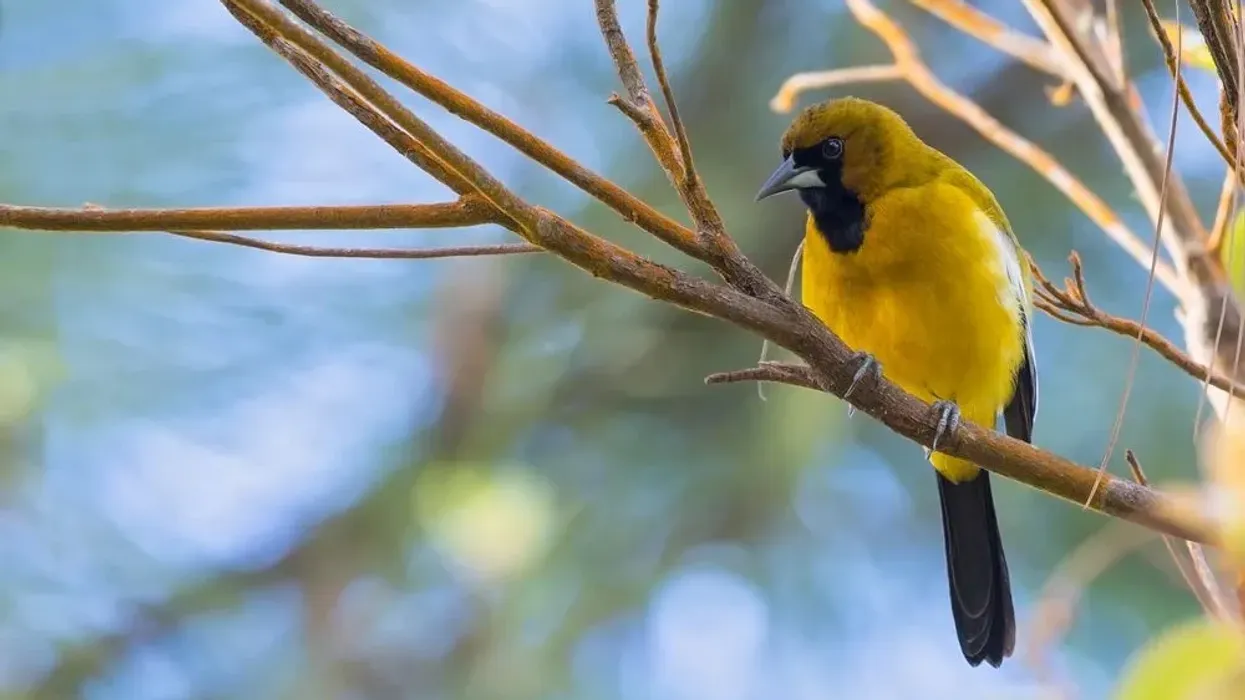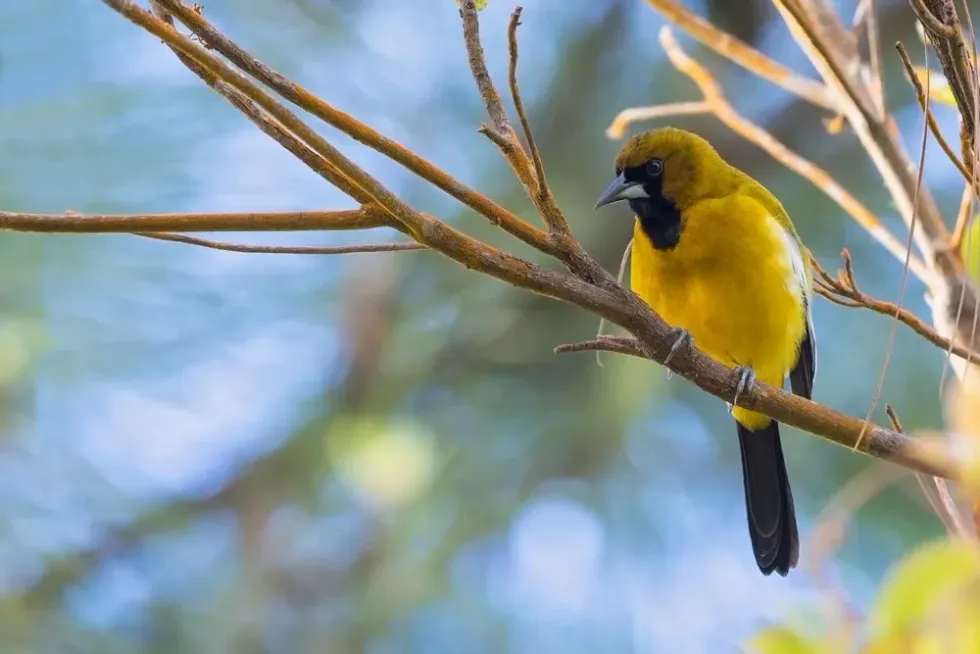Do you want to know more about birds like the rusty blackbird? If yes, then get ready to learn about the Jamaican oriole that belongs to the same family of Icteridae and order Passeriformes.
The scientific name for this bird species is Icterus leucopteryx, and its genus Icterus stands for New World orioles. This bird can be easily identified with its bright yellow body which is contrasted by its black mask and tail.
Moreover, you can also spot large white marks on its wing coverts. The species hails from Jamaica and the Colombian island of San Andrés.
Formerly, a group used to live in the Cayman Islands, but they have since gone extinct. Even though it's from the Caribbean, this bird is said to be closer to the orange orioles of North America.
The natural habit of this bird is in the lowland subtropical and tropical forests, but it can also veer towards gardens and other places on the islands except for marshes. It's quite a common bird available in Jamaica and sources do saw that currently, it has a stable population.
The International Union for Conservation of Nature (IUCN) has also categorized it under the status of Least Concern.
Want to know more about this New World bird? Keep reading for interesting Jamaican oriole facts. Also, check out our palm warbler facts and American pipit facts to learn more about birds from America.
Jamaican Oriole Interesting Facts
What type of animal is a Jamaican oriole?
The Jamaican oriole (Icterus leucopteryx) is a bird species from the family Icteridae that stands for New World blackbirds. It's thought to be closely related to the North American species, the orange orioles. Also, the Brewer's blackbird species belong to the same family as the Jamaican oriole.
What class of animal does a Jamaican oriole belong to?
The Jamaican oriole belongs to the class Aves, to the order Passeriformes, to family Icteridae, and to the genus Icterus.
How many Jamaican orioles are there in the world?
We didn't find any sources or references where the exact population of this species was specified. However, based on past data and its recent population trend this bird is thought to be fairly common in Jamaica.
Where does a Jamaican oriole live?
These birds were mainly found in three Caribbean areas - Jamaica, the Colombian island of San Andrés, and the Grand Cayman of Cayman Islands. However, the population found in the Cayman Islands has gone extinct as the last birds were seen in the 1960s.
What is a Jamaican oriole's habitat?
When it comes to the natural habitat, these birds aren't really fussy about their forests. In Jamaica, they are found in lowland tropical and subtropical woodlands along with gardens or agricultural areas. At times, these birds can also be found in forests on top of mountains. However, this species is never seen near mangroves or marshes.
Who do Jamaican orioles live with?
Jamaican orioles are usually found in groups or pairs while the birds are looking for food in the forests.
How long does a Jamaican oriole live?
The lifespan of a Jamaican oriole (Icterus leucopteryx) is thought to be around 12 years in its natural tropical and subtropical habitat.
How do they reproduce?
The breeding season of this species is thought to be around March to August. And, in the natural habitat, these birds form monogamous pairs and build solitary nests during breeding.
Both the male and the female take part in nest building during the breeding season, and its usually lined with palm leaves. Even epiphytic Spanish moss or horsehair can also be found in the nests.
Rather than building the nests on the floors of tropical or subtropical forests, during the breeding season, this species will find forks of trees or suspended branches to make the nest. And, this nest usually hangs.
Based on previous data, the female usually lays three to five eggs that are mostly white with specks of brown. During the breeding season, both parents take care of the chicks.
What is their conservation status?
According to the International Union for Conservation of Nature (IUCN) Red List, the Jamaican oriole (Icterus leucopteryx) is placed under the status of Least Concern. However, the birds found in San Andrés are thought to have vulnerable because of their low population.
Jamaican Oriole Fun Facts
What do Jamaican orioles look like?

When it comes to the appearance of these medium-sized birds, you can easily spot them because of their bright yellow plumage that's contrasted by black and white feathers on their wing coverts.
The Jamaican oriole male has an olive sheen to the yellow feathers which can be easily spotted on the top of its head. With a closer look, you will be able to notice the black mask on its face that also drops to the neck region.
Their tail is also fully black, while the feet have a gray appearance.
This species is known for having a thick black and white bill that allows it to probe the bark of trees present in tropical and subtropical forests. Otherwise similar, the Jamaican oriole female might have a duller plumage compared to the male.
The juveniles look a bit different as their plumage has more olive tones and their tail is also distinctly green. It's also said that the subspecies Icterus leucopteryx lawrencii, which resides in San Andrés, has more green to its plumage while its underparts can be lemon yellow.
How cute are they?
Just like hooded orioles, the Jamaican oriole (Icterus leucopteryx) looks quite cute and the contrast of its black wings and yellow body is absolutely breathtaking.
How do they communicate?
Both the male and female of this bird species are known for a similar song that's quite beautiful. There's a whistling quality to the songs and it sounds like 'tie-tiewu', or 'tie-tiewu-tiewu'.
Their songs are quite similar to the other Caribbean and North American orioles. A funny thing about one of the songs made by this species is said to sound like 'Auntie Katie'. Their songs may also vary a little based on the season.
How big is a Jamaican oriole?
The average body size range for this bird is around 8.2 in (20.8 cm) for both the male and the female. Compared to it, the orchard oriole has a body size range of around 5.9-7 in (15-17.7 cm).
How fast can a Jamaican oriole fly?
There is no data regarding how fast the Jamaican oriole can fly.
How much does a Jamaican oriole weigh?
The average weight range of this bird is around 1.1-1.4 oz (31.1-39.6 g).
What are the male and female names of the species?
There are no separate names for the male and female of this species.
What would you call a baby Jamaican oriole?
A baby Jamaican oriole is called a chick.
What do they eat?
The Jamaican oriole has an omnivorous diet and it mainly feeds on fruits, nectar, worms, and insects. Its diet mainly includes fruits found in the lowland tropical and subtropical regions such as oranges, papayas, apples, pimentos, and bananas.
Apart from using probing, these birds also use bark-flaking while feeding. The thick bill of this bird helps it to look through the barks of trees to find suitable insects which can consume two-thirds of its diet.
Are they dangerous?
Do you really think that such a small bird can pose a threat to you? Yes, it might be more dangerous if you are an insect, but it isn't big enough to harm a human being!
Would they make a good pet?
No, these birds or any other species of orioles aren't meant to be your pets.
Did you know...
As the Jamaican oriole (Icterus leucopteryx) has a diet of fruit, like bananas, these birds are also known as banana katies.
This bird belongs to the genus Icterus which contains 25-30 species of New World orioles.
Most orioles are common birds and aren't rare. However, the Bahama oriole is thought to be one of the rarest orioles of the Caribbean.
There's a common misconception that orioles are finches, but that isn't true. There is a bird called the oriole finch which is a species of finch that looks similar to an oriole, but it does belong to the Fringillidae family like other finches.
Apart from the Jamaican orioles, there are several other species of birds present in Jamaica like ducks, flamingos, cuckoos, swifts, and hummingbirds to name a few.
Are Jamaican orioles endangered?
The Icterus leucopteryx Jamaican oriole endangered is not a thing in Jamaica as there the birds are quite common and widely available. Whereas the birds living in San Andrés are thought to be vulnerable as only a small population persists. Unfortunately, the population that formerly lived in Grand Cayman became extinct without leaving a clue about the disappearance.
Are Jamaican orioles migratory?
No, Jamaican orioles don't migrate and are thought to be a fairly sedentary species.
Here at Kidadl, we have carefully created lots of interesting family-friendly animal facts for everyone to discover! For more relatable content, check out these belted kingfisher facts and mountain bluebird facts for kids.
You can even occupy yourself at home by coloring in one of our free printable Baltimore oriole coloring pages.
Second image by Charles J. Sharp.










